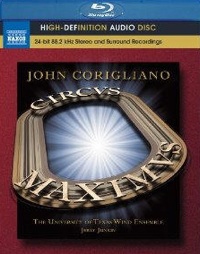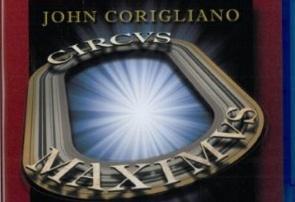
Circus Maximus is a scream. Is it the scream of sensation, the roller coaster, and the funhouse, or is it a cri de coeur against the Jerry Springerization of the planet, as its composer intended? In either case, it’s an impressive piece of workmanship, if a debatable work for the ages. At a minimum, in its latest incarnation as a high-definition Blu-ray disk, it’s a first-class device for showing off your latest surround-sound system.
The music is composer John Corigliano’s Third Symphony, for a wind band and percussion — and it comes with a message. As its composer has articulated:
Many of us have become as bemused by the violence and humiliation that flood the 500-plus channels of our television screens as those mobs of imperial Rome who considered the devouring of human beings by starving lions just another Sunday show. The shape of Circus Maximus was built both to embody and comment on this massive and glamorous barbarity.
Massive and barbarous it is indeed, in five of its eight movements. And its three quiet movements seem to offer little or no hope — despite a penultimate “Prayer” — resulting in calamity and carnality without catharsis. Within its limitations, however, there is much to admire:
- An idée fixe fanfare that can wake the dead and that recurs almost too often, despite providing structural usefulness
- A mastery of orchestration that continually intrigues the ear (“How did he do that?”) and makes the piece sound nothing at all like a band piece — strings do not sound “missing” whatsoever
- A dynamic range that should be measured in parsecs rather than decibels
Listen To The Music
Symphony No. 3, "Circus Maximus" (excerpts)I. Introitus
V. Night Music II
For best effect, this disc (available in both Blu-ray and CD formats) should be played in a soundproof room. Even the CD version should not be played in a car — the need for twisting the volume knob back and forth makes the music as dangerous as texting while driving. It has been called the loudest piece for acoustic instruments ever written, though it has some strong contenders, especially Christopher Rouse’s Gorgon. (I think Rouse wins this contest because his plywood platform smashed with sledge hammers at the end is louder than Corigliano’s concluding, real-live shotgun blast. But Maximus manages to surpass Jan Leifs’ Hekla, with its chain-bashed boulders.)
The piece begins with the fanfare, then moves to “Screen/Siren,” which seems to depict a drug-hazed prostitute. Then comes “Channel Surfing,” an amazingly eclectic mess of short-attention-span mayhem, followed by “Night Music I,” full of ominous emptiness and doglike howls. “Night Music II” is the best movement of the bunch: To me, it epitomized the back room of a sleazy nightclub, where a victim is being beaten and tortured for information. Occasionally, the door opens and the raucous main room of the club with jazz band is heard. The fanfare returns in the sixth movement, “Circus Maximus,” where a parade of grotesqueries marches by, building up to a gargantuan blast of white noise, which all too slowly fades into the dubiously churchy music of “Prayer.” The coda brings back the fanfare yet again, plus the concluding firearm.
It’s quite an experience, though not one you’d like to repeat often if you’re mentally stable. And it’s not the same as hearing it live, when instruments are placed all over the venue and march around. (The Blu-ray does have some fine spatial effects, however.) Excerpts are fabulous for demonstrating that your system is better than the Joneses’.
The last 17 minutes of the disc are devoted to a straightforward band piece that sounds like a band piece, called Gazebo Dances. Of the four movements, the Overture is fun, and the concluding Tarantella is appropriately lively and short. But, unlike its partner on the disk, it’s nothing to scream about.

